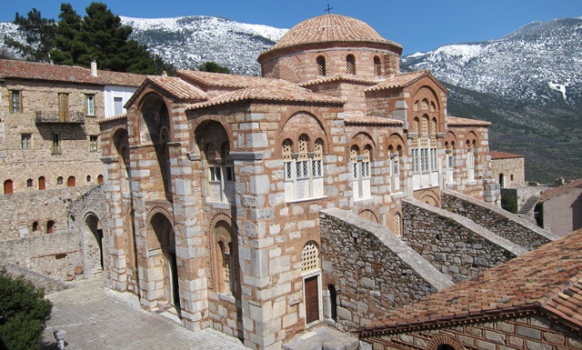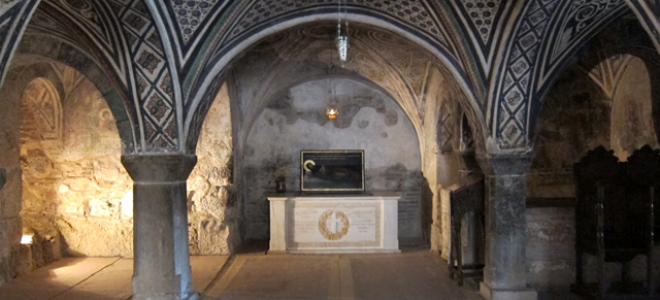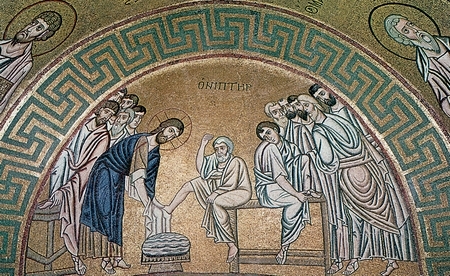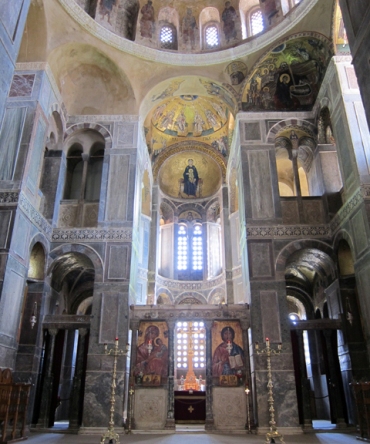
The grand Monastery of Saint Lukas was built in the west of the mountain Elikonas, beneath the Acropolis of ancient Stirida, near the village Stiri, at Viotia. It is one of the most significant monuments of Byzantine art, mainly because of its mosaic and, since 1990, it has been included in the world heritage of monuments of UNESCO, together with, the Monasteries of Nea Moni of Chios and Dafni in Athens.
The Monastery is dedicated to Saint Lukas of Stirio (7th February 953). The Monastery, which is dedicated to the thaumaturgical Saint Lukas, together with its two big churches (the temple of Panagia (Virgin Mary) and the Catholicon), the Kripti (crypt), the belfry, the cells and other buildings, acquired great fame in a very small period of time because its kind of art is considered a model for the byzantine monuments of the 11th century throughout Greece.
Two years after the death of Saint Lukas, his disciplines and other recluses who lived there perfected and decorated the church of Saint Barbara, turned the cell, where Saint Lukas was buried, into a sacred pilgrimage, which was cross-shaped, and created new cells and guesthouses.

At the times of the Greek revolution of 1821, the Monastery became Rumeli’s starting point of the Revolution. On 27th March 1821, Isaias, the Bishop of Salona, blessed the revolutionaries of Rumeli and declared the beginning of the Revolution officially.
After Omer Vrioni’s setting fire to Livadia in June 1821, the scattered revolutionaries were gathered at Saint Lukas’ Monastery and began their way back to Morias. Odysseas Androutsos began his way back from Saint Lukas too, some months later and conquered Livadia again. As Dramalis was moving southern, the Turks destroyed Saint Lukas’ Monastery completely. (1822, 1823). However, the Monastery managed to survive again, giving all its property for the sake of the Revolution.
In 1943, the Monastery suffered again because of the German conquerors. However, since 1938, the Archaeological Services and the Archaeological Company of Greece had already started hard work, which lasted for a lot of years, in order to maintain the Monastery in a good situation. They restored the Refectory as well as other buildings of the Monastery. During all these works, the wall painting of Jesus of Navi was revealed and the two temples were rebuilt and restored correctly.

The Catholicon, that was probably built at the first decades of the 11th century, is attributed, according to some traditions, to three Emperors of the Byzantium: Romanos the II (959 – 963), Vasilios Vulgaroktonos (976 – 1028) and Constantinos the IX the Monomachos (Gladiator) (1042 – 1056).
The Catholicon has had the most well-preserved mosaic sets since the period of the Macedonian Renaissance, at the Byzantium times.
However, there is something missing from these mosaic sets. The original image of Christ the Pantocrator, in the dome, is absent as well as the images of the archangels that are usually placed between the upper windows.
However, there is evidence that the Monastery was famous, in all over the Byzantium, because of its lavish decoration, which was obvious in every corner of the Monastery.
Feast days of the Monastery:
- 1.7th February: Religious festival.
- 2.3rd May: Saint Lukas’ relics were translated and it is also the anniversary of the inauguration of the Catholicon of the Monastery.
- 3.3rd May: Kiriaki ton Propatoron (meaning the Sunday that is dedicated to our Church founding fathers. On this day, the relics of Saint Lukas were retranslated).
- 4.15th August: feast day of the church of Kimisi tis Theotokou (the church is dedicated to the Dormition of the Virgin, the day when Virgin Mary died, on the 15th August).
Access to the Monastery
The Monastery of Saint Lukas is 165km away from Athens, 32 km away from Livadia and 35km away from Delfi. If you come from Athens, you should come from the ring road of Livadia, follow the direction of Delfi and finally head towards Distomo, taking into account the road signs that indicate the exact position of the Monastery.

Phone numbers of the Monastery: 2267022228, 2267021305
The picture was taken by the Cathedral Church of Thiva and Livadia.













